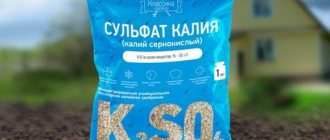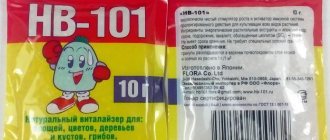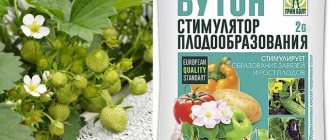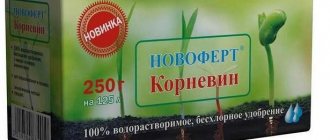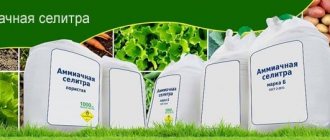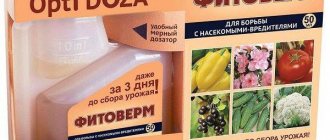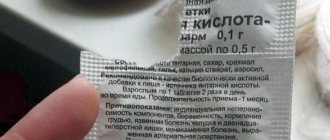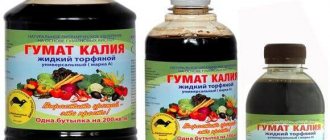45% of chemicals are perfect for caring for gardens, cottages and home flower beds. You just need to know their properties and ability to influence soil and plants. Knowledge about hidden capabilities and methods of application in different areas of human activity will be important.
One of the chemical elements that can affect the improvement of the growth and development of garden crops is magnesium sulfate. Its composition in the form of fertilizer is suitable for both indoor and outdoor flowers.
Reason: the presence of mineral supplements in the complex. The composition of the substance helps restore the plant's immune system. But the use is recommended more for prevention purposes.
Composition and chemical formula
Magnesium sulfate is an inorganic chemical compound. The chemical formula or composition contains only two elements:
- magnesium;
- sulfuric acid.
The production of the substance has been established, since the properties of the powder are universal and are popular in industry, medicine and horticulture. The biological processes that occur with the help of magnesium contribute to the development of tissues and cellular composition in the body of plant and animal origin.
Properties and range of applications:
| Scope of use | Qualities |
| Life | Paper industry. Obtaining refractory material |
| Medicine | Reducing pressure and excessive excitability of the nervous system. Suitable as a choleretic and laxative. Promotes increased diuresis |
| Construction | Covering for airfields and roads. Often added to cement mixture |
Need to know! Absorption by living organisms (plant and animal origin) is better if magnesium is administered with water or food. For flowers and plant crops, it is better to introduce magnesium sulfate into the soil in liquid form.
Safety precautions when working with the product
Magnesium sulfate belongs to the category of safe and effective plant nutrition products.
When working with the drug, it is necessary to take into account some features:
- Magnesium sulfate, when stored and moved for a long time, forms dust, which, if it comes into contact with the skin, can provoke various forms of dermatitis, therefore it is recommended to use thick protective gloves when working with the drug.
- If magnesium sulphide powder gets on the mucous membranes of the eyes, temporary loss of vision, itching, and irritation may occur, so eye protection is recommended.
- In order to prevent the development of consequences hazardous to health after working in the garden or on a personal plot, it is necessary to thoroughly wash your hands, change clothes, and additionally treat the tools with which the plants were processed.
Magnesium sulfate is a fertilizer that every gardener is familiar with. If used correctly, magnesium sulfate can become an “ambulance” for any crop. An excess of magnesium during treatments can provoke irreversible changes in plants, therefore it is recommended to maintain the correct proportions when preparing working solutions.
Area of use
Anhydrous magnesium sulfate is widely used in everyday life and medicine. It also plays a significant role in gardening and gardening. With its help, plants not only develop faster. They make up for the lack of microelements important for life: magnesium by 17%, and sulfur by 13-14%.
Magnesium sulfate replenishes any soil and living organism with two active elements. Accordingly, use will not cause damage to the soil. But the best option for application is acidic, alkaline soil.
Before application, you will need to carry out a number of procedures for better absorption. It is also noted by agricultural experts that fertilizers with magnesium do not pollute the environment and do not produce sediment in the form of pesticides. But they differ from others in that they improve the taste of a vegetable or fruit.
You can purchase the drug at any garden and dacha store. The first on the list of manufacturers of fertilizer mixtures is OJSC Buysky Chemical Plant. The company produces 65% of all fertilizers that gardeners and their “green pets” urgently need.
Buoy fertilizers enjoy positive reviews. They are developed by qualified chemists. Substances quickly adapt. Suitable for drip irrigation, protected and open ground, in greenhouses.
Storage conditions
The substance is low-hazard, non-toxic, harmless to the environment. When storing, the time period is taken into account (usually up to a year), but most often gardeners use small bags for one season.
Store the fertilizer in sealed packaging from the manufacturer, in places protected from open sunlight, preferably in a separate closet, out of reach of children and pets.
Do you want to get high yields on your plot? Then be sure to study the information on magnesium sulfate and include it in your feeding schedule. Proper use of fertilizer will provide plants with the necessary beneficial microelements.
Rate this post
Efficiency for plants
Magnesium sulfate is used quite often for plants as a fertilizer and for prevention. It can be used as an independent substance or in combination with other preparations to improve soil or photosynthesis and development.
The effect that fertilizer has on plants gives them a marketable appearance. That is why, if there is a plot of land of 5 or more hectares, gardeners and farmers choose magnesium sulfate. For people who have a household, it is not necessary to buy a stove heating substance.
It will come from wood ash, which is a combustion waste. Furnace ash contains all the necessary microelements. But there is one “BUT”: magnesium will be enough, but sulfur will have to be added.
Analogs
Among fertilizers containing magnesium, a large share is made up of potassium-magnesium and lime-magnesium fertilizers. Some of them (raw salts) are highly soluble, others (ground minerals and rocks) are not.
Gardeners and gardeners use magnesium sulfate analogs for fertilizing and improving soil composition:
- potassium magnesia;
- dolomite flour (liming of acidic soils);
- dolomite ammonium nitrate.
Before use, carefully study the description and instructions, prepare solutions according to the indicated dosages.
How to understand that plants lack magnesium
In gardening, magnesium sulfate is important for all types of plants, including shrubs and trees. But it is advisable to feed them regularly if there is a deficiency of sulfur and magnesium. External signs will help determine the lack of substances. They are similar for both fruit trees and garden crops, flowers (garden, indoor):
- If fruits are present, pay attention to full ripening. If berries, tubers, etc. do not ripen properly or on time, this is evidence of impaired metabolism. Absorption of beneficial microelements is low.
- Examine the leaves from the outside and inside. Changes in color along the edges or in the middle, drying out, wilting of buds, falling leaves - a lack of magnesium, which is at a critical level.
- The leaves can be covered with a pattern that looks like marble. Indicator of decreased chlorophyll production.
If there is insufficient amount of sulfur, these signs are supplemented by: slower growth and discoloration of the green part. This happens gradually.
Important role
Magnesium is not one of the main minerals that form the building blocks of plants in the form of phosphates, potassium nitrate and nitrogen compounds. Its place is greater in the list of microelements along with iron, calcium and similar substances from the periodic table.
But green chlorophyll in its structure is nothing more than a magnesium complex. Having caught a photon of light, it is the magnesium ion that triggers a complex chemical reaction with the release of an oxygen molecule into the environment. But not only. What it does is it then allows the plant to grow green mass and form ATP - adenosine triphosphoric acid. Which then directly forms the tissues of ripening grains in cereals, the pulp of fruits in vegetables and fruits.
And working in combination, magnesium and sulfur in the sulfate composition allow the accumulation of ascorbic acid (vitamin C) in fruits.
The sulfate compound MgSO4 is the most easily digestible for plants (if you do not take into account volatile SO2 in the atmosphere. In urgent cases of wilting or stunted growth in plants, you can simultaneously spray and water with magnesium sulfate dissolved in water, in which magnesium and sulfur, respectively, are 16 and 13 %.
Where is it used?
Without the use of magnesium sulfate as a fertilizer, it will not be possible to grow high-energy plant products needed for the production of children's and sports nutrition. As well as medicinal herbal preparations.
And in the production of food additives it is difficult to do without it: the well-known additive E 140 is a specially purified chlorophyll. So not all “E-shki” are equally harmful.
Read: Use of iron chelate for feeding garden and ornamental crops.
The use of magnesia is also useful when growing:
- All types of cabbage.
- Bobovykh.
- Beetroot.
- Garlic and onions - both onions and green varieties.
- Yagod.
- Peppers and eggplant.
- Apples and cherries.
When liming acidic soils with dolomite flour, remember that the content of magnesium in pure form and in the form of sulfates is increased! Therefore, if magnesium compounds are added, it will be necessary to recalculate the amount of this element.
For what soils is it used?
In a garden with black soil, fertilizers are applied as needed or when the risk of soil dehydration increases. To do this, the feeding procedure is carried out for preventive purposes. But there are types of soil for which magnesium is vital due to its low presence or complete absence.
Mineral fertilizer is always required on sandy and acidic soil. Substances found in these types of soils can harm plants. Reason: high acidity, which prevents magnesium from being absorbed sufficiently.
Root method
To carry out root feeding of plants, you need to prepare a fertilizer solution. Calculate the required amount of fertilizer, and, after thoroughly stirring, dilute it in warm water. Water the ground with the prepared solution within a radius of half a meter (approximately) from the plant trunk.
Expert opinion on magnesium sulfate:
Magnesium sulfate is responsible for water balance and replenishes the crops’ need for sulfur and magnesium compounds. The peculiarity of the drug is its rapid response, due to the content of active substances in the form of oxides. Do not apply magnesium sulfate to dry soil - it will not work! It is acceptable to apply before the snow melts, in the autumn after harvesting.
Anatoly Baykov
For perennial plants, as well as shrubs and trees, dry granules can be used. To do this, during the period of snow melting in the spring, the soil around the trunk is dug in, magnesium sulfate is distributed over it, and then sprinkled with a layer of earth.
How to use correctly
The instructions for use of sulfate contain the necessary recommendations for the preparation and use of the substance. The powder is soluble, free-flowing. It is allowed to be administered in mixed form, pure and diluted in water for spraying. Dosages are also indicated for each crop separately.
Preparation of solution and dosage
Magnesium sulfate heptahydrate is easy to dilute. The working fluid has a standard formula: add substances per 10 liters according to the needs of the plant, its condition at the time of application, and take into account the type of soil. The dosage and concentration of the substance is adjusted after studying all the necessary points.
For potatoes
Foliar fertilizing with magnesium for root crops is carried out in dry form. The powder is scattered evenly over the hole. The calculation is made per square meter: from 15 to 20 g. Before planting potatoes in the soil, the substance is also allowed to be added: dosage up to 20 g per square meter. m., then dig up.
Compatibility with other fertilizers
To prevent an acute shortage of magnesium and sulfur, the fertilizer is used together with nitrogen fertilizers. In the first half of the season, it helps in the absorption of nitrogen fertilizers. For example, combined application with urea will give plants a good start.
Combination with various humates (sodium, potassium) as a growth stimulant is acceptable.
Magnesium sulfate goes well with mineral supplements:
- In tank mixtures, fertilizer is mixed with phosphate fertilizers.
- Simultaneous application with dolomite and complex fertilizers (azophoska, borophosphoska, diammofoska) is acceptable.
- The combination of magnesium and boron is beneficial for strawberries and strawberries. In late April-early May, when leaves appear, leaf spraying is the most effective way to feed berry bushes. Special preparations are produced (for example, MagBor). For feeding, it is enough to dilute 1 tsp. of the drug in 10 liters of water and treat the plants leaf by leaf.
Advice from an experienced farmer
Tomatoes in indoor plantings often experience heat stress. Signs of heat stroke are leaves curling upward, “into a boat.”
For feeding plants and against excessive dry air, along with shading and chalk treatments of the bush in the greenhouse, a comprehensive application of magnesium sulfate and silicon additives will help. The source of silicon is liquid glass, silicate glue.
Reference . Magnesium and silicon, according to plant experts, significantly increase the heat resistance of crops. In the summer heat, green mass can withstand a temperature increase of 5-7C above permissible standards.
Preparation of the rescue solution:
- 1 tsp. silicate glue;
- 1 tbsp. l. magnesium sulfate;
- the ingredients are mixed, dissolved in 1 liter of water;
- Add 8-9 liters of settled water at room temperature to the mother solution, stirring continuously.
Spray the tomatoes with the prepared solution.
Caution . Silicate solutions are incompatible with tank mixtures of microelements:
- iron;
- copper;
- calcium.
Reviews about the application
Victoria. I used magnesium for pelargoniums. I heard more than once that the mixture helps, so I took a chance. The ornamental plant began to recover quickly. After a detailed study of the instructions, I came to the conclusion: magnesium sulfate is a unique remedy for all types of plants.
Eugene. Magnesium sulfate is definitely beneficial for all types of garden crops. With his help, I became the owner of a magnificent harvest. The quality is superior to even the most expensive goods (vegetables, fruits) in the supermarket.
Advice from professionals
Magnesia sulfate can be applied together with other agrochemicals. Agronomists recommend using fertilizer when preparing the soil for planting seeds.
In the fall, it is best to add magnesium to the soil in its pure form, and then dig it up with mineral complexes. Over the winter, the salts will dissolve and the substrate will take on a form in which the root system of young seedlings takes root and adapts much faster.
Due to the fact that the drug does not inhibit vegetation, it can be added together with pesticides.
Magnesium sulfate has a positive effect on the yield and quality of fruits
Attention! When using an aqueous solution and dry powder, do not forget about safety measures. Magnesia may cause itching, redness and allergic reactions (urticaria).
Why is sulfur needed?
Sulfur works as part of a common team, helping to build the structure of chlorophyll when growing plants. Sulfur is also a component of amino acids that form proteins in plants. Sulfur is indispensable for legumes, because with its participation, special nodules that fix nitrogen are formed on the roots of plants of this family. It is sulfur compounds that have a healing effect for people (anti-sclerosis, anti-cancer, antimicrobial, etc.) in all vegetables of the cruciferous family (cabbages, radishes, radishes, mustard, horseradish) and alliums (garlic, onions). Tomatoes, peppers and cucumbers also especially need sulfur. Signs of sulfur starvation: leaves turn pale, herbaceous stems become abnormally woody, growth slows down.
Foliar method
Magnesium sulfate is perfectly absorbed by leaves. Therefore, this fertilization method is used to prevent magnesium deficiency during drought periods.
It is necessary to prepare a solution of magnesium and add urea to it at the rate of 5 g for every 10 liters of liquid. This is necessary to prevent chemical burns of the leaves.
When foliar feeding, weather conditions are taken into account. Fertilization is not carried out:
- in windy weather;
- at high temperature;
- during times of increased solar activity.
Recommended conditions are evening, cloudy or cloudy weather, provided there is no heat.
Foliar method of fertilizing with magnesium
